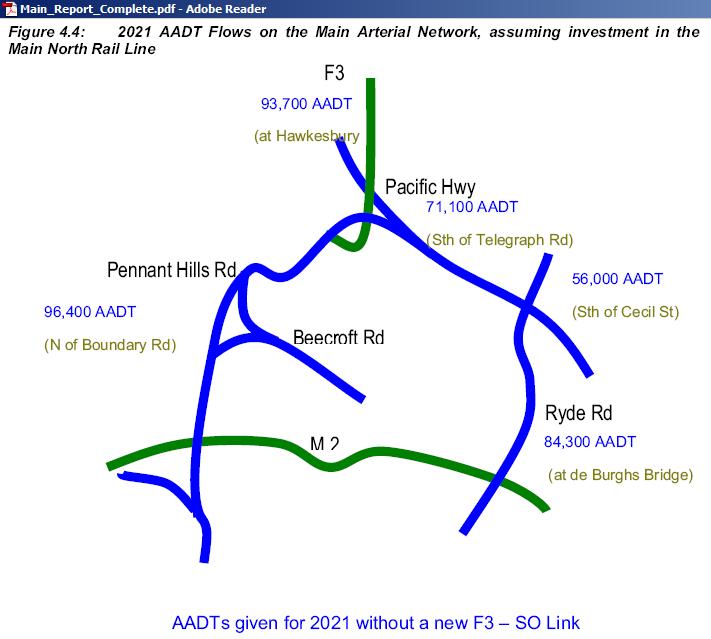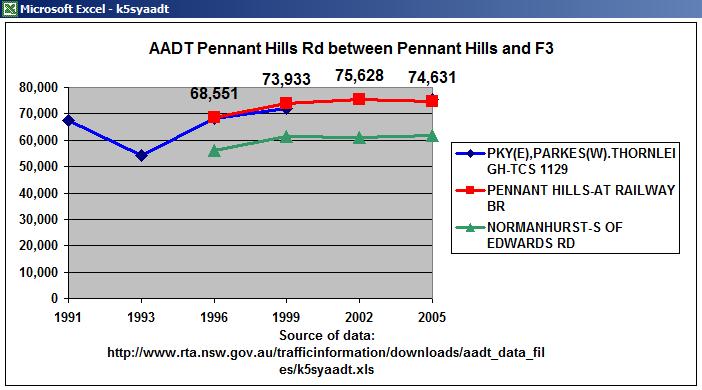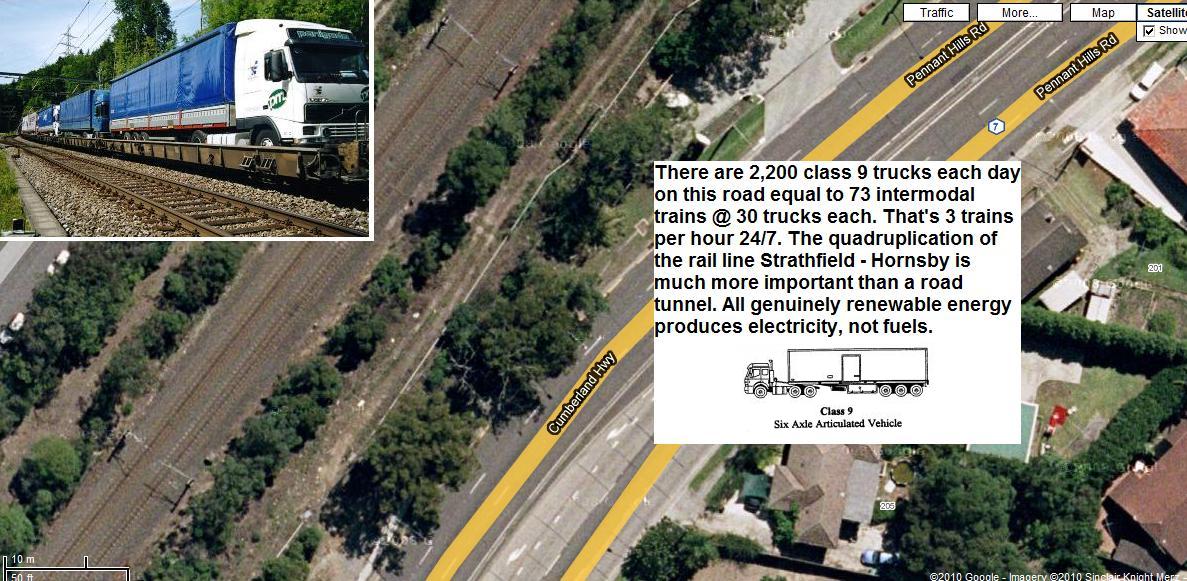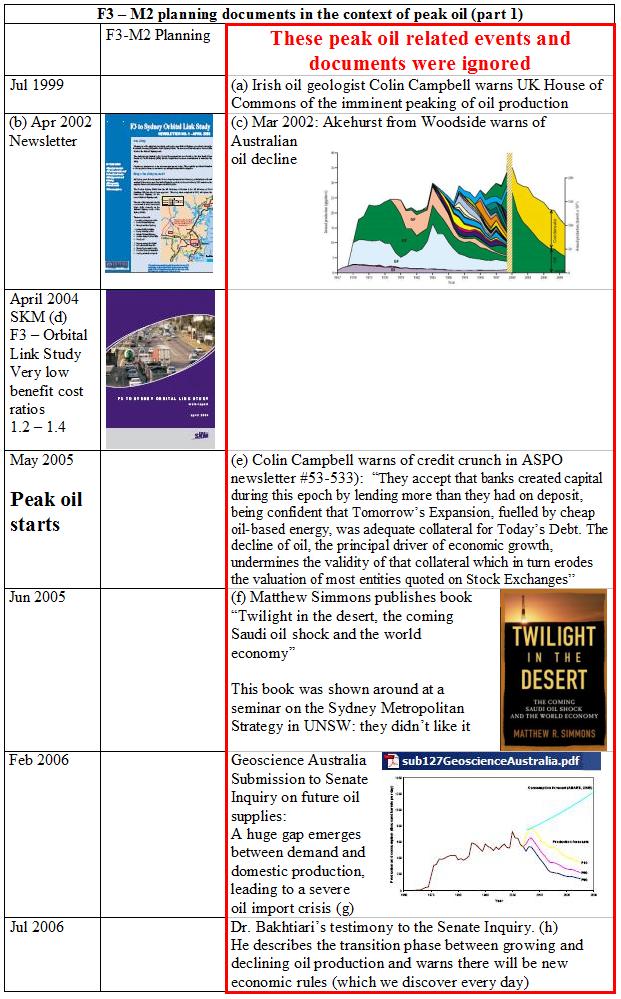No lessons learned from the financial collapse of the Lane Cove Tunnel?
Summary: Only days after the financial collapse of the Lane Cove Tunnel the NSW government continues to plan road tunnels. An F3-M2 tunnel under the Pennant Hills Rd, for example, was assessed by SKM in 2004 (based on 2003 construction costs and assuming a doubling of traffic over 40 years) and summarized as follows:
| Effect of a Toll The BCR [benefit cost ratio] results suggest that the project with a car and truck toll of $3.50 is marginal in economic terms and that the Purple dual 2 lane project would be the only tolled scheme of those assessed which would be close to passing Treasury’s economic efficiency test with a BCR in excess of 1.0 |
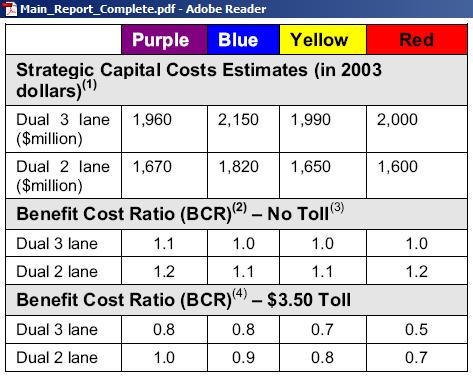 These are very low BCRs, which should be in the order of 3-4 at least to make a project worthwhile. Values of 1.0 need further investigation and a sensitivity analysis on physical oil and energy supplies, not just oil prices.
These are very low BCRs, which should be in the order of 3-4 at least to make a project worthwhile. Values of 1.0 need further investigation and a sensitivity analysis on physical oil and energy supplies, not just oil prices.
http://www.infrastructure.gov.au/roads/F3toM7Review/pdf/Main_Report_Complete.pdf
In other words: This tunnel is not economic when taking into account higher construction costs and less traffic after another oil price shock and/or physical shortages.
Details:
These 2 recent newspaper articles remind the public that the NSW and Federal governments continue planning road tunnels:
(1) Residents fear new tunnel exhaust stacks
January 30, 2010
A PROPOSAL to build a motorway beneath the upper north shore has found support from the Federal Government but angered locals, who fear it will scar the landscape with exhaust emission stacks.
The NSW Government is considering two plans for tunnels that link the M2 tollway between the Hills District and Lane Cove with the F3 freeway from Wahroonga to Newcastle. The Federal Government is willing to offer $150 million for planning and consultation work.
http://smh.drive.com.au/residents-fear-new-tunnel-exhaust-stacks-20100129-n498.html
$150 million for planning and consultation work? That money should be put into the full quadruplication of the rail line Strathfield – Hornsby. Every day freight trains get stuck at the Thornleigh loop.
(2) Labyrinth threatens to eat city
January 16, 2010
The Evans & Peck proposal links the Inner West Bypass directly to a new tunnel that would follow the Victoria Road alignment from Rozelle to Hunters Hill and then to Lane Cove, where it would join the M2. A new tunnel would follow the Pacific Highway alignment from Pymble to Wahroonga, where the F3 begins
http://smh.drive.com.au/labyrinth-threatens-to-eat-city-20100115-mcgg.html
http://www.evanspeck.com/Working%20Files/Publications/EPMotorwaysPaper.pdf
(3) So what were the lessons from the Lane Cove Tunnel collapse? http://www.crudeoilpeak.com/?p=998
- Tolls were too low to cover the enormous costs of road tunnels (mill. $ per km)
- Short term debt could not be re-financed
- Traffic projections were manipulated
Would any other road tunnel rate better? Of course not. Construction costs have, if anything, increased and assumed traffic growth is physically impossible after global crude oil production started to peak in 2005 at around 74 mb/d. Peak oil has triggered the financial crisis in economies already overburdened with accumulated debt. Debt which was used to grow the economy against limited oil supplies. Money printing, new debt and debt moved from the private sector to governments have created new threats: sovereign debt failures.
The list of countries in danger is here, in a graph entitled “ring of fire:
http://www.pimco.com/LeftNav/Featured+Market+Commentary/IO/2010/February+2010+Gross+Ring+of+Fire.htm
The shortage of credit caused a recession in most of the OECD countries, decreasing oil demand and a subsequent drop in oil prices.
This obscures the peaking of oil production. None of this has helped to fight rampant decline in existing oil fields. The world is now facing declining oil production. Should economies recover, leading to increased global oil demand, the next oil price shock is certain.
Australia is in the last quarter of its oil age and highly dependent on what is happening with the Chinese economy. China in turn would need increasing annual oil imports to grow. This oil is simply not there. For the time being China consumes the oil the OECD is saving but for how long? Read this post:
9/11/2009
World needs to save at least 3 mb/d by 2020 for China to grow. Any volunteers?
http://www.crudeoilpeak.com/?p=525
To assume in this situation that traffic will grow in perpetuity for decades as in the past is completely unrealistic. Yet, this is exactly what traffic studies are projecting. This untested assumption is the cause for the continuing road tunnel frenzy.
(4) Let’s go into some details of the 2004 “F3 to Sydney Orbital Link study which can be found here:http://www.infrastructure.gov.au/roads/F3toM7Review/study_2004.aspx
“Over the last 20 years Sydney’s population has grown by an average of 1.2% per year but travel demand (in terms of passenger kilometres of travel) is estimated to have grown by about 2.7% per year, or more than twice the population growth rate.
Over the next 40 years Sydney’s population is predicted to grow by a further 50% to some 6 million people. On past trends, total travel is likely to at least double in some corridors over this period, even if integrated transport planning, significant investments in rail, and travel demand management policies are implemented.
This study has assumed that travel behaviours are unlikely to change significantly over the study’s 20 year horizon and that the current dominance of car/road mode of travel, at almost 90% of the total citywide passenger kilometre task, together with the lack of any obvious trend to alternative modes will continue over this period.” p4-8
The simple methodology used for traffic projections seems to be:
Step 1: Past traffic growth 2.7 % pa from past population growth 1.2% pa
Step 2: Future 40 year population growth is 50%
Step 3: Therefore traffic doubles
In 2021, daily traffic volumes on the major arterial roads in northern Sydney would grow by at least 30% compared with flows in 2001. p 4-9
So that is a growth rate of 1.5% pa. However, RTA statistics, which are publicly available up to 2005, reveal that traffic has actually stagnated, albeit at capacity levels:
http://www.rta.nsw.gov.au/trafficinformation/downloads/aadt_data_files/k5syaadt.xls
What’s more important, no analysis has been done about where the energy will come from to support growing traffic.
- There is no oil geological mechanism by which population growth in Sydney would increase Australian oil production, not to mention global oil supplies
- There is no carbon free primary energy available to replace oil in the quantities required to offset declining oil production
In fact, population growth will increase all resource related problems. In one of the next phases of peak oil there will be petrol shortages and then motorists will understand that new arrivals mean longer petrol lines and will demand an end to the current immigration program. Natural population growth will be limited by food production and transport.
(5) Solution: the quadruplication of the Northern Rail Line is much more important than a new road tunnel. 2,200 class 9 trucks = 73 intermodal trains per day @ 30 trucks each.
References on items of the above table:
(a) http://www.hubbertpeak.com/Campbell/commons.htm
(b) Public consultation newsletter April 2002
“As Sydney grows there is expected to be a large increase in travel demand, particularly in north and western Sydney where more than half of Sydney’s population is forecast to live by 2020 and where the majority of new residential developments will take place.”
http://commcons.skm.com.au/f3tosydneyorbital/documents/newsletter_april02.pdf#zoom=80
(c.) http://www.stcwa.org.au/papers/data/oil_vuln.doc
(d) http://www.infrastructure.gov.au/roads/F3toM7Review/pdf/Main_Report_Complete.pdf
(e) Colin Campbell’s newsletter May 2005 http://www.peakoil.net/Newsletter/NL53/newsletter53.pdf
http://www.youtube.com/watch?v=lDNMjV6sumQ
(f) May 2005 Matt Simmons’s Book Twilight in the desert
http://www.simmonsco-intl.com/files/Twilight%20Launch.pdf
http://www.simmonsco-intl.com/files/Twilight%20in%20the%20Desert%20Presentation.pdf
(g) Submission 127 of Geoscience Australia
(h) July 2007 Transcript of Dr. Bakhtiari’s testimony to the Senate Inquiry on oil supplies
Warning of new economic rules and the transition phase from growing to declining oil productionhttp://www.aph.gov.au/hansard/senate/commttee/S9515.pdf
(i) Sep 2007 F3-M7 Review report
This conclusion may not be a direct answer to the claims raised in the submissions, but these claims are actually beyond my terms of reference. The same comment may be made about global warming and peak oil issues. This Review has been directed to focus on the assumptions and data in the SKM Study, changes to land use and transport flows and the outcomes of the SKM Study. However, I note these claims for completeness, and so that they will not be lost sight of in any further progress of the Link. Page 82
http://www.infrastructure.gov.au/roads/F3toM7Review/pdf/F3toM7_final.pdf
My submission: End of Freeways – the tipping points of Peak Oil and Global Warming
http://www.crudeoilpeak.com/?p=48
(j) Oct 2007 Sadad al Husseini’s presentation to the Oil & Money Conference 2007 in London
300 Gb of OPEC oil (=30 years supplies) reclassified from reserves to resources
http://www.energyintel.com/om/program.asp?Year=2007
(k) http://www.iea.org/weo/2008.asp
(l) In a stark warning to Britain and the other Western powers, Dr Birol said that the market power of the very few oil-producing countries that hold substantial reserves of oil – mostly in the Middle East – would increase rapidly as the oil crisis begins to grip after 2010.
http://www.independent.co.uk/news/science/warning-oil-supplies-are-running-out-fast-1766585.html
(m) http://www.evanspeck.com/Working%20Files/Publications/EPMotorwaysPaper.pdf
(n) 9/11/2009 Key oil figures were distorted by US pressure, says whistleblower
http://www.guardian.co.uk/environment/2009/nov/09/peak-oil-international-energy-agency
More details here: http://www.crudeoilpeak.com/?p=564
Download this article as PDF file: [download id=”19″]




